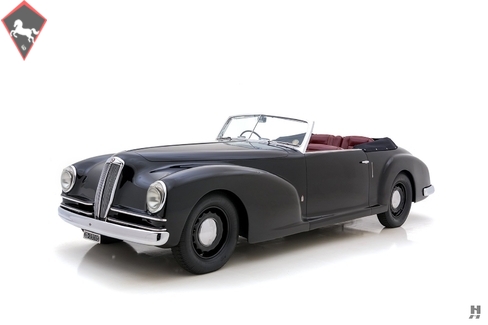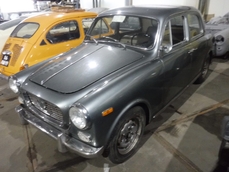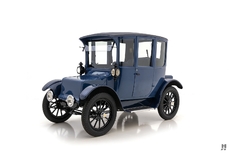Lancia Other 1938
Allmän beskrivning :
When the Astura debuted in 1931, Lancia was already well-established as one of the most respected automobile manufacturers in the world. The brilliant engineer Vincenzo Lancia gave life to such vehicles as the Kappa, Lambda, and Dilambda – all revered for their advanced engineering, superb build quality, and revolutionary design features. Because Lancia was a small company, new models often overlapped with outgoing ones, as was the case with the Astura, which sold alongside the Dilambda for the first few years. Like the Dilambda, the Astura featured a separate chassis rather than the stressed unitary body of the Lambda. While arguably a step back technologically, this allowed Italy’s finest coachbuilders to work their magic on the otherwise brilliant platform. The design was shared with the four-cylinder Artena, though the Astura served the flagship role thanks to the superb, ingenious narrow-angle V8 engine. The Astura formed the basis of some of the most spectacular of all pre-war Lancias, favored by Italy’s cultural and political elite throughout the 30s.
For the Series III, the Astura gained the three-liter version of the V8 engine, hydraulic brakes, and the option of short or long-chassis variants. The final Series IV version, built between 1937 and 1939, featured the same mechanical spec but was only available in a long-wheelbase form. Coachbuilders across Europe made the most of Lancia’s superb flagship, and stunning designs came from the likes of Pourtout, Castagna, Stabilimenti Farina, and the fledgling Pinin Farina – which would go on to create many breathtaking creations based on the Astura.
As one of the last Asturas built, chassis number 413195 is a long-wheelbase fourth-series example, wearing sophisticated and elegant one-off cabriolet coachwork by Pinin Farina. According to the marque historian and collector Hervé Charbonneaux, himself a past owner of this car, S/N 413195 was completed on November 17, 1938, bound for Carrozzeria Pinin Farina. The chassis was said to be a special order by Count Galeazzo Ciano, Benito Mussolini’s son-in-law, and his right-hand man as the chief propagandist in the fascist government. Like many high-ranking Italian officials, Ciano was a Lancia connoisseur and had at least one other Astura in his private stable. But just as 413195 arrived at the coachbuilder’s workshop, Italy’s involvement in World War II interrupted all of Italian industry, meaning Pinin Farina would not complete the job until after the war. Unfortunately for Count Ciano, he would never take delivery of his Lancia. When he suggested Italy may be on the losing side of WWII, Mussolini summarily stripped him of his post for what he saw as the ultimate betrayal of trust. In 1944, Ciano met his fate by firing squad on Mussolini’s orders.
The Astura remained at the Pinin Farina workshop through the end of the war. With auto production in Italy at essentially zero, coachbuilders were desperate for work. They began pushing the boundaries of design to attract what few buyers still had the means for bespoke coachwork. In 1947, Pinin Farina completed the striking body for 413195, debuting it on their stand at the Turin Auto Show the same year. It was apparently purchased by noted art collector and French aristocrat Baron Napoleon Gourgaud, where it lived a gentle life as part of his Paris museum. In 1971, Philippe Charbonneaux and his son Hervé purchased the Lancia from the Gourgaud collection and displayed it at their museum near St. Dizier. The collection still exists as the Musée automobile Reim-Champagne, and a film on their website from 1972 momentarily captures the Astura, appearing to remarkably sound and in original condition at the time – albeit a bit dusty.
It is understood that the next owner was Marco Gastaldi, who acquired it from the Charbonneaux collection in 1977 and owned it through 1992. In 1993, Gastaldi sold it to Carlo Montorfano, who commissioned Italian restorer Mario Galbiati to perform a mechanical overhaul and cosmetic freshening, preserving the car’s original interior. It changed hands again in 2007 and has since been in the care of devoted enthusiasts who have maintained it in superb condition.
The imposing and grand Astura possesses a remarkable presence. Pinin Farina’s brilliance is on full display, making the most of the 137-inch wheelbase with a graceful and sophisticated fully-enveloped design that was years ahead of its time. The lack of excessive trim or finicky grille designs is in stark contrast to many early post-war cars, and the car exudes quiet elegance. It is strikingly finished in black, with black wheels, black-wall Michelin tires, and finely restored brightwork. The interior was recently restored, with the rich burgundy leather true to original specifications and providing a perfect contrast to the understated livery. Paint and coachwork are superb, with exquisite panel alignment and detailing.
It might be a surprise to the casual onlooker to learn the Astura has a V8 under the bonnet. Topped with a single cylinder head, it is astonishingly compact and a stunning display of engineering, particularly since it was designed nearly a century ago. The engine compartment is clean and well-detailed, reflecting some occasional use and remaining true to original specifications.
This astonishing Lancia Astura participated in the 2021 Pebble Beach Concours d’Elegance, where it completed the road tour without fault and took First in Class in a highly competitive grouping of European open coachbuilt cars. It has also been shown at the highly prestigious Concorso d’Eleganza Villa d’Este and is accompanied by a FIVA passport and Automoclub Storico Italiano registration papers, ensuring its eligibility for a wide range of road events and concours. This is a rare opportunity to acquire a significant piece of Lancia and Pinin Farina history that is sure to be a breathtaking centerpiece to any collection.
Offers welcome and trades considered
1938 Lancia Other is listed till salu on ClassicDigest in St. Louis by Hyman Ltd. for $850000.
Fakta i bilen
Karosstyp : Personbil Märke : Lancia Modell : Other Motorvolym : 0.0 Årsmodell : 1938 Karosstyp : Convertible Läge : Missouri Fordon Registrering : Odefinierad
850000 $
People who viewed this Lancia Other also viewed similar Lancia listed at ClassicDigest
Other cars listed for sale by this dealer
om Lancia
Åh, Lancia, den italienska tillverkaren som dansade på gränsen till bilbriljans! Låt mig ta med dig på en resa genom den fängslande historien om Lancia, ett varumärke som personifierar passion, innovation och rallyframgång.Akt 1: De Tidiga Åren (1906-1920-tal)
Lancia grundades 1906 av Vincenzo Lancia, en ingenjör med en fallenhet för det extraordinära. Märket fick snabbt rykte för sitt precisionsteknik och innovativa tillvägagångssätt. Lancia Alpha, introducerad 1907, var den första bilen med en snäv V4-motor och satte tonen för Lancias engagemang för teknisk excellens.
Akt 2: Innovation i Kärnan (1930-tal-1950-tal)
1930-talet såg Lancia pressa gränserna för innovation med modeller som Lambda, den första bilen med en självbärande monocoque-chassi. Aprilia, introducerad på 1930-talet, visade banbrytande aerodynamik och en V4-motor, vilket förstärkte Lancias rykte som pionjär.
Akt 3: Efterkrigstidens Elegans (1950-tal-1960-tal)
Efter andra världskriget fortsatte Lancia att imponera med modeller som Aurelia, den första serietillverkade bilen med en V6-motor. Den förenade prestanda med komfort och elegans. Flaminia följde och inkarnerade lyx och avancerad teknik.
Akt 4: Rallydominans (1970-tal-1980-tal)
Lancia etsade sitt namn i motorsporthistorien med en oöverträffad rallyarv. Lancia Stratos, ett kilformat underverk, dominerade rallyscenen på 1970-talet och säkrade tre på varandra följande Rallye-VM från 1974 till 1976. Delta Integrale, introducerad på 1980-talet, fortsatte detta rallyherravälde med flera mästerskap.
Akt 5: Utmaningar och Motståndskraft (1990-tal-2000-tal)
Det senare partiet av 1900-talet förde ekonomiska utmaningar för många biltillverkare, och Lancia var inget undantag. Trots svårigheterna introducerade Lancia modeller som Thesis och Ypsilon och visade sitt åtagande för stil och substans.
Akt 6: 2000-talets Återuppfinning (2010-tal-nutid)
På 2010-talet mötte Lancia förändrad strategi och fokuserade på Ypsilon som sitt huvudmodell. Även om produktionsvolymerna minskade behöll varumärket sitt rykte för distinkt design och komfort.
Epilog: Ett Arv av Passion och Innovation
Lancias historia är en av passion, innovation och rallyglans. Märket, med sina banbrytande designer, teknologiska framsteg och rallytriumfer, har lämnat ett outplånligt avtryck på bilvärlden. Lancia kan ha stött på utmaningar de senaste åren, men dess arv lever vidare, firat av entusiaster som känner igen magin vävd i varje Lancia-skapelse.

























